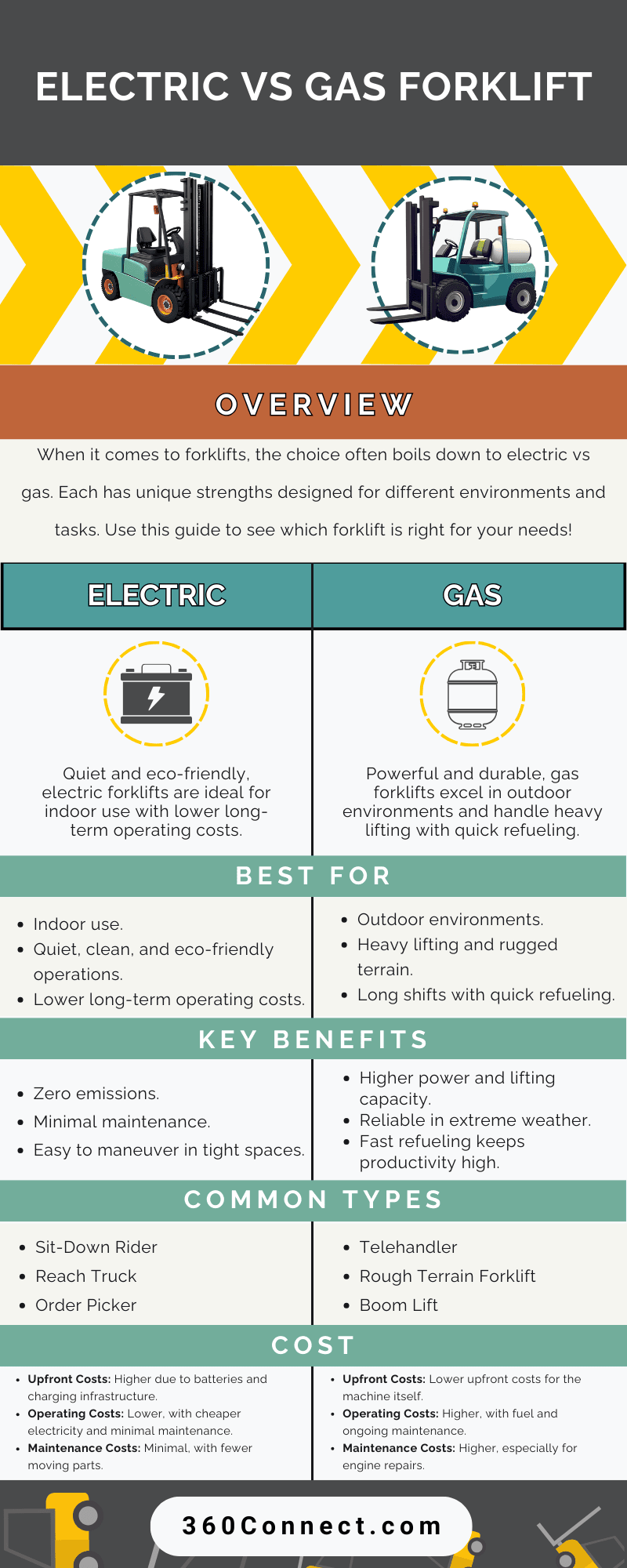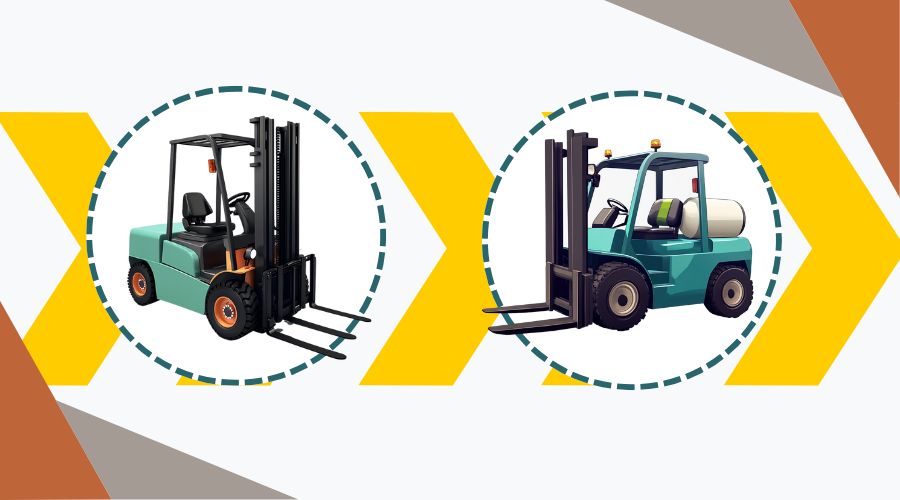If you’re shopping for a forklift, you’ve probably noticed there are two main contenders: electric vs gas. At first glance, they might seem pretty similar—they both move, lift, and store heavy materials—but dig a little deeper, and you’ll find they’re built for very different needs.
Choosing the right forklift is more than just a budget decision. It’s about finding the one that fits your work environment, load requirements, and long-term goals. Do you need something quiet for indoor use? Or are you handling heavy loads on a rugged outdoor site?
In this guide, we’ll break down everything you need to know about electric and gas forklifts—how they work, their benefits, and which industries they serve best. By the end, you’ll have a clear idea of which one is right for you. Let’s dive in!
Electric vs Gas Forklift: Overview
To begin with, let’s look at an overview of what sets electric and gas forklifts apart before we get into the nitty-gritty:
- Electric Forklifts are powered by rechargeable batteries. They’re quiet, eco-friendly, and designed for controlled environments like warehouses. They’re ideal for businesses focusing on sustainability or looking to save on fuel costs.
- Gas Forklifts use engines powered by propane, diesel, or gasoline. They’re robust and designed for tough jobs in outdoor environments or industries requiring heavy lifting.
Both types have their strengths, but the right choice depends on where and how you’ll use the forklift. Let’s break each type down further.

Electric Forklifts
Electric forklifts are all about precision, efficiency, and adaptability for indoor workspaces. They run on rechargeable batteries, making them a quiet and emissions-free option. You’ll often find these forklifts in warehouses or facilities where maintaining air quality and reducing noise is critical for both safety and employee comfort.
Because electric forklifts don’t rely on fuel, they’re also much cheaper to run over time. However, the need for charging stations and regular battery maintenance can mean higher upfront setup costs.
Common Use of Electric Forklifts
Electric forklifts are perfect for environments where low noise and zero emissions are essential. They’re a popular choice in industries like food storage, manufacturing, or retail, where forklifts operate in close proximity to employees or sensitive goods. You’ll see electric forklifts in places like:
- Warehouses: Moving pallets or inventory through tight aisles.
- Retail Stockrooms: Handling goods in temperature-controlled environments.
- Pharmaceutical Companies: Ensuring operations are clean and compliant.
Common Types of Electric Forklifts
- Sit-Down Rider: Ideal for indoor use and versatile for various material-handling tasks.
- Reach Truck: Designed for navigating high shelves in tight warehouse spaces.
- Order Picker: Perfect for picking individual items from inventory racks.
- Scissor Lift: Provides vertical lifting for maintenance or inventory access.
Related: Different Types of Forklifts
Who Uses Electric Forklifts?
- E-commerce businesses: Managing massive indoor inventory systems.
- Food distributors: Prioritizing safety and cleanliness.
- Retailers: Stocking shelves and managing storage behind the scenes.
5 Benefits of Electric Forklifts
- Clean Operation: No fumes or emissions to worry about, making them safe for indoor use.
- Quiet Performance: Great for reducing noise levels in busy warehouses.
- Cost Efficiency: Lower operating costs compared to gas forklifts, thanks to cheaper electricity and minimal maintenance.
- Compact Design: Smaller and easier to maneuver in tight indoor spaces.
- Eco-Friendly: Helps businesses meet sustainability goals or emission regulations.
Gas Forklifts
Gas forklifts are tough, reliable machines built for power and endurance. They’re ideal for heavy lifting, long shifts, and outdoor conditions. Unlike electric forklifts, they don’t rely on charging—they run on propane, diesel, or gasoline, which can be refueled quickly and easily.
While gas forklifts are noisier and produce emissions, they make up for it with strength and versatility. If you’re handling rugged materials or working in less controlled environments, these are your go-to machines.
Common Use of Gas Forklifts
Gas forklifts excel in environments where durability and power are essential, such as construction sites or outdoor yards. You’ll often see gas forklifts at:
- Construction Sites: Moving building materials like lumber and steel.
- Outdoor Yards: Transporting heavy pallets or equipment.
- Shipping Facilities: Loading and unloading freight containers.
Common Types of Gas Forklifts
- Telehandler: Great for construction sites with extended reach capabilities.
- Rough Terrain Forklift: Built to handle outdoor and uneven terrain.
- Boom Lift: Used for lifting personnel and tools to high and hard-to-reach areas.
Who Uses Them?
- Construction companies: Navigating uneven terrain while carrying heavy loads.
- Logistics providers: Maximizing efficiency in outdoor shipping hubs.
- Industrial warehouses: Handling large, bulky materials without a hitch.
5 Benefits of Gas Forklifts
- Unmatched Power: Can handle heavier loads than electric models.
- Quick Refueling: No downtime waiting for a charge—just swap out a propane tank or refuel.
- Tough in Any Weather: Operates reliably in extreme heat, cold, or rain.
- Longevity: Built to last through heavy-duty, long-term use.
- High Speed: Faster acceleration and lifting compared to their electric counterparts.
Electric vs Gas Forklift: Cost
It’s tempting to look at the “sticker price” alone, but the real cost of a forklift includes much more.
| Cost Factors | Electric Forklift | Gas Forklift |
|---|---|---|
| Upfront Costs | Higher due to batteries and charging infrastructure | Lower upfront costs for the machine itself |
| Operating Costs | Lower, with cheaper electricity and minimal maintenance | Higher, with fuel and ongoing maintenance |
| Maintenance Costs | Minimal, with fewer moving parts | Higher, especially for engine repairs |
The global forklift market overall was valued at $65.16 billion in 2023 and is projected to grow at a CAGR of 13.5% through 2030, highlighting the increasing demand for these machines in industries like e-commerce and manufacturing.
Related: How Much Does a Forklift Cost?
Electric vs Gas Forklift: Pros & Cons
| Electric Forklift Pros | Electric Forklift Cons |
|---|---|
| Quiet and clean | Limited battery life |
| Lower total cost of ownership | Charging infrastructure required |
| Environmentally friendly | Less suited for outdoor use |
| Gas Forklift Pros | Gas Forklift Cons |
| Stronger lifting capacity | Higher operating costs |
| Quick refueling keeps productivity high | Noisy and produces emissions |
| Reliable in tough environments | Not ideal for indoor air quality |
Final Thoughts: Electric vs Gas Forklift— Which Should You Choose?
When it comes to choosing between an electric or gas forklift, it’s all about finding the right fit for your work environment and operational needs.
- Choose an electric forklift if: You work indoors, prioritize eco-friendliness, and want to save on operating costs.
- Choose a gas forklift if: You need power, durability, and a machine that can handle outdoor environments or heavy loads.
If you’re still unsure, take the time to evaluate your current setup. Where will the forklift be used most? What types of loads will you handle? And what are your long-term business goals? Once you answer these questions, you’ll be well-equipped to make the best decision.
Electric vs Gas Forklift: How to Buy a Forklift
So, now that you know the key differences between an electric and gas forklift, where do you buy a forklift in general, and how do you ensure you’re working with a reliable supplier? Here’s a quick guide to streamline your purchasing process:
- Assess Your Needs
Consider where you’ll use the forklift, the types of loads you’ll move, and your budget. - Research Suppliers
Look for reputable suppliers with positive reviews and a strong track record. - Compare Options
Use an online marketplace to get quotes from multiple suppliers. This ensures you get the best deal and have access to a wide range of options.
By working with an online marketplace like 360Connect, you gain access to trusted suppliers who match your needs. This helps you compare prices, evaluate quality, and find the best forklift for your business.
Ready to Buy a Forklift?
At 360Connect, we help businesses connect with top suppliers to find the equipment they need. Click the button below and get 5 FREE forklift quotes. It’s that easy!

